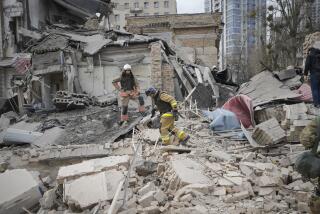A Profligate Crusade
Defense spending, with the excuse of wartime, is out of control. The House’s vote Friday to boost military spending for next year above the $379 billion requested by the Bush administration to almost $400 billion is beyond lavish and is blind to deficits. The most conspicuous outrage is a bid to restore funding for the obsolete-before-it’s-built 42-ton Crusader howitzer.
Defense Secretary Donald H. Rumsfeld has made killing the Crusader a test of his ability to transform the military into a lighter and more mobile force. President Bush has rightly vowed to veto legislation that would fund the Crusader, but creating a post-9/11 military that fights terrorism, not the old Soviet Union, will require more sweeping cuts.
Almost forgotten in Congress’ rush to pour on the defense dollars is that the original Bush budget proposal was already larded with questionable weapons.
As a presidential candidate, Bush pledged to “skip a generation” of weapons systems so that new, unconventional weapons could be funded. But last summer Rumsfeld ran into so much flak from the military brass and Congress over his plans to hold down spending and restructure the military that it looked as though he would have to resign.
After Sept. 11, Rumsfeld made a smashing comeback, including his star turns explaining and defending U.S. military actions at televised press conferences. But at the same time he largely gave up trying to force Congress and the military to make painful choices between old and new weaponry. The administration simply threw money at the problem.
Bush had declared during the campaign that he would cut funding for redundant warplanes, but included in his proposed 2003 budget is $12 billion for the Navy’s Super Hornet, the Air Force’s F-22 Raptor and the Joint Strike Fighter. Then there is the $3 billion slated for the Marines’ beloved V-22 Osprey, a vertical-takeoff plane that keeps crashing.
But this wasn’t enough for the House, which approved $3.2 billion more than the administration requested to replace aging aircraft and other weapons and $1 billion in Navy shipbuilding increases, not to mention exempting the military from environmental regulations.
But the first issue is the clunky Crusader, which Rumsfeld has correctly called a Cold War relic that will hardly intimidate Middle East terrorists since it is designed to bombard heavy troop concentrations. It does not even exist yet in prototype, so no one even knows if it would work as designed.
Rumsfeld wants to use the $11 billion budgeted for the Crusader on high-tech weaponry like the Predator drone that was so effective in Afghanistan.
The aim of the military cannot be to match a massively armed adversary, nuclear missile for nuclear missile or plane for plane. Instead, it has to plan for rapid dispatch to and nimble maneuvering in the Third World. Spending should be focused on the so-called transformational technologies--pilotless planes, precision munitions and real-time information networks that give commanders instant views of the battlefield.
Congress and too many of the military brass are fighting old wars, not the new one against highly mobile terrorism. Bush’s veto of the Crusader will restore strength to Rumsfeld’s hand. The Defense secretary should put everything he can into achieving the reforms he promised soon after he came into office.
More to Read
Get the L.A. Times Politics newsletter
Deeply reported insights into legislation, politics and policy from Sacramento, Washington and beyond. In your inbox three times per week.
You may occasionally receive promotional content from the Los Angeles Times.










